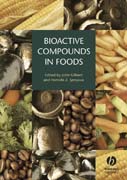
Inherent toxicants and processing contaminants are both non-essential, bioactive substances whose levels in foods can be difficult to control. This volume covers both types of compound for the first time, examining their beneficial as well as their undesirable effects in the human diet. Chapters have been written as individually comprehensive reviews, and topics have been selected to illustrate recent scientific advances in understanding of the occurrence and mechanism of formation, exposure/risk assessment and developments in the underpinning analytical methodology. INDICE: Introduction.Professor John Gilbert, Central Science Laboratory, Sand Hutton, York, UK; and.Dr Hamide Z. Senyuva, Ankara Test and Analysis Laboratory, Scientific and Technical Research Council of Turkey, Ankara, Turkey.Part 1 Natural toxicants.1. Pyrrolizidine alkaloids.Colin Crews, Central Science Laboratory, Sand Hutton, York, UK; and.Professor Dr Rudi Krska, Christian Doppler Laboratory for Mycotoxin Research, Center for Analytical Chemistry, Department for Agrobiotechnology (IFA-Tulln), University of Natural Resources and Applied Life Sciences, Tulln, Austria.2. Glucosinolates.Dr Ruud Verkerk and Dr Matthijs Dekker, Department of Food Technology and Nutrition Science, Agricultural University Wageningen, The Netherlands.3. Phycotoxins in seafoods.Dr John Leftley Scottish Association for Marine Science, Oban, Argyll, Scotland, UK and Integrin Advanced Biosystems Ltd., Marine Resource Centre, Barcaldine, Argyll, Scotland, UK; and.Dr Fiona Hannah, University of London, University Marine Biological Station, Millport, Isle of Cumbrae, Scotland, UK.4. Mushroom toxins.Professor Jana Hajslova, Institute of Chemical Technology, Prague, Czech Republic.5. Mycotoxins.Mr Keith Scudamore, KAS Mycotoxins, Taplow, Berkshire, UK.6. Phytoestrogens.Dr Don Clarke, Central Science Laboratory, Sand Hutton, York,UK.7. ß-Carboline alkaloids.Dr T. Herraiz, Spanish Council for Scientific Research, Madrid, Spain.8. Naturally-occuring Nitrates and Nitrites in foods.Dr M. Reinik, Estonian Health Protection Inspectorate, Tartu Laboratory, Tartu, Estonia.Dr T Tamme, Estonian University of Life Sciences, Department of Food Science and Hygiene, Tartu, Estonia.Dr M. Roasto, Estonian University of Life Sciences, Dept. of Food Science and Hygiene, Tartu, Estonia.Part II Man-made components.9. Acrylamide in heated foods.Dr Hamide Z. Senyuva, Ankara Test and Analysis Laboratory, Scientific and Technical Research Council of Turkey, Ankara,Turkey.Dr Vural Gökmen, Food Engineering Department, Hacettepe University, Ankara, Turkey.10. Furan in processed foods.Dr Imre Blank, Science Department Head, Nestle Product Technology Center, Orbe, Switzerland.11. Chloropropanols and chloroesters.Dr Colin Hamlet, RHM Technology Ltd, The Lord Rank Centre, HighWycombe, Bucks, UK.12. Hetrocyclic amines.Dr M. Knizel, University of California, Lawrence Livermore National Laboratory, Biology & Biotechnology Research Program, Livermore, CA, USA.13. Polycyclic Aromatic Hydrocarbons.Dr M. Rose, Central Science Laboratory, Sand Hutton, York, UK.Dr Laura Cano-Lerida, JohnsonMatthey Catalysis, Belasis Avenue, Chilton, Billingham, UK.Dr P. Walton, Department of Chemistry, University of York, Heslington, York, UK.
- ISBN: 978-1-4051-5875-6
- Editorial: Blackwell
- Encuadernacion: Cartoné
- Páginas: 432
- Fecha Publicación: 23/05/2008
- Nº Volúmenes: 1
- Idioma: Inglés
